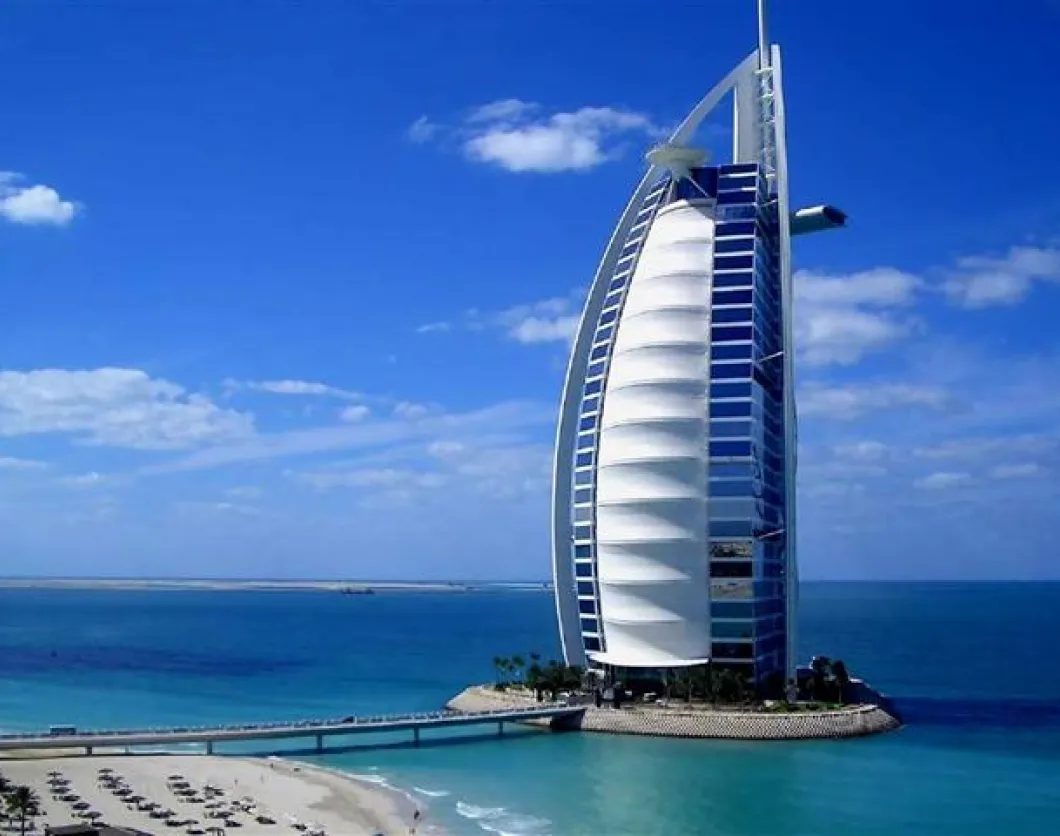United Arab Emirates or UAE, for short, is transforming the face of tourism and hospitality industry by creating nature inspired artificial islands and bolstering trade based activities. UAE’s capital, Dubai, is as a result of these one of the most visited cities in the world. The number of visitors is expected to hit 15 million in the near future as the country switches focus from oil to service based economic models.
The artificial islands’ magnificence is boosted by a combination of architectural, land reclamation and engineering ingenuity. The Persian Gulf city therefore offers travelers and hospitality industry investors a chance to be part of one of the greatest human endeavors since the building of Egypt’s ancient pyramids.
Burj Al Arab
Known in English as “Tower of the Arabs”, Burj Al Arab has a special place in the global hotel ranking spectrum. It commands the rare 7 star status in addition to being the world’s first hotel to tower above 1000 feet. Approximately 39% of the hotel’s total height supports 9,000 tons of steel and 70,000 cubic meters of concrete making up the ship sail-like building on the artificial island 280 meters off the white sandy shorelines of Dubai.
A single night in the USD 650 million establishment can be a pricey thrill. The hotel’s cheapest suit, for instance, goes for about a thousand dollars a night. According to tourism and hospitality experts, the idea behind the artificial-island hotel was to draw in high-end market travelers who can afford the rates as well as the middle income travelers who may be in search of man-made marvels. Therefore, if you can’t afford any of the hotel’s 202 suits, taking a trip to the UAE just to see it from the shores of Dubai can be as exciting as admiring China’s Great Wall or France’s Eiffel Tower from distance.
The Palm Islands: The Palm Jumeirah, The Palm Jebel Ali, and The Palm Deira
Dubai’s Palm Islands were conceptualized and designed in line with the shape of a palm tree to give them a natural and relaxing outlook. The Guardian reports that though the construction of Palm Jebel Ali is currently on hold with half of its landfill done, the two islands are expected to accommodate 65,000 people upon completion. These include travelers, business community and professionals to help run restaurants, parks, shopping malls, banks, medical and sport facilities. Palm Jumeirah was scheduled to open in 2008 but its construction got constricted by the 2008-2009 global economic problems.
Palm Jebel Ali is the second largest of the artificial island trilogy. It differs from the rest in design as its fronds incorporate inner and outer rings. The design gives all sorts of travelers the opportunity to enjoy lovely broadwalks which engulfs the fronds besides theme parks, a sea village in addition to aesthetic homes and apartments on stilts.
Deira Island was originally anticipated to be the biggest of all the three islands. With 300 million cubic meters of sand already laid, the project hasn’t been jump-started since it stalled in 2008 as a result of financial, design and environmental concerns. The three islands are projected to extend UAE’s coastline by over 500 kilometers.
The World Islands
The World Islands project, also in Dubai, was first announced in 2003 attracting a throng of private investors who currently own 60% of the reclaimed land, forming the artificial islands. The 300 island project arranged in shapes that mimic the world map, came to a standstill in 2008 following the global economic downturn. Only two islands have been developed.
Lebanon Island opened its gates to travelers and the business community in 2012 irrespective of this and is today host to private parties and commercial events. The islands range from 14,000 to 42,000 square meters with the distance between them standing at 100 meters. These enclaves the global community in a manner that seeks to remind people how small and fun-bubbling the world can get.
Dubai Waterfront
Dubai Waterfront’s design is chiseled out to be the world’s largest construction project. The artificial island will stretch UAE’s coastline by 70 kilometers, cover 1.4 billion square feet of land and water and accommodate up to 1.5 million people. Its architectural aspects are as well designed to shelter Jebel Ali Island from strong winds but its construction process is currently on hold owing to a USD 11 billion debt that the lead constructor incurred in 2009 as a result of global economic recession.
The Universe
The coming of the Universe artificial islands was first mentioned in January 2008. The group of islands is expected to be completed between 2023 and 2028. It may however take longer to complete since the project is currently on hold as a result of design and financial complications. Upon completion the artificial archipelago will transform UAE’s coast into a heavenly Milky Way on water.










